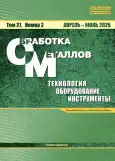Ensuring hole shape accuracy in finish machining using boring
- Authors: Stelmakov V.A.1, Gimadeev M.R.1, Nikitenko A.V.1
-
Affiliations:
- Issue: Vol 27, No 2 (2025)
- Pages: 89-102
- Section: TECHNOLOGY
- URL: https://bakhtiniada.ru/1994-6309/article/view/301428
- DOI: https://doi.org/10.17212/1994-6309-2025-27.2-89-102
- ID: 301428
Cite item
Abstract
Keywords
About the authors
V. A. Stelmakov
Email: 009062@togudv.ru
Ph.D. (Engineering), Pacific National University, 136 Tihookeanskaya St., Khabarovsk, 680035, Russian Federation, 009062@togudv.ru
M. R. Gimadeev
Email: 009063@togudv.ru
Ph.D. (Engineering), Pacific National University, 136 Tihookeanskaya St., Khabarovsk, 680035, Russian Federation, 009063@togudv.ru
A. V. Nikitenko
Email: 005392@togudv.ru
Ph.D. (Engineering), Pacific National University, 136 Tihookeanskaya St., Khabarovsk, 680035, Russian Federation, 005392@togudv.ru
References
- Real-time compensation of tool deflection using a sensor embedded boring bar with wireless signal feedback to the machine tool controller / D. Östling, P.K. Brede, T. Jensen, R. Bjønnum, O. Standal, P.I. Sæthertrø, L.O. Björling, T. Holmströmb // 9th CIRP Conference on High Performance Cutting (HPC 2020). – 2021. – Vol. 101. – P. 102–105. – doi: 10.1016/j.procir.2020.09.191.
- Черноиванова А.Г., Тарасенко Б.Ф., Оськин С.В. Ресурсосберегающее устройство для расточки корпусных отверстий // Чрезвычайные ситуации: промышленная и экологическая безопасность. – 2015. – № 2–3. – С. 81–88.
- Маслов А.Р., Молодцов В.В. Моделирование колебаний инструментальной системы для растачивания отверстий // Вестник МГТУ "Станкин". – 2014. – № 4. – С. 196–199.
- Повышение точности растачивания отверстий в сварных корпусах / А.Л. Бахно, А.С. Ямников, А.С. Васильев, А.О. Чуприков // СТИН. – 2019. – № 6. – С. 38–40.
- Du W., Wang L., Shao Y. A semi-analytical dynamics method for spindle radial throw in boring process // Journal of Manufacturing Processes. – 2023. – Vol. 96. – P. 110–124. – doi: 10.1016/j.jmapro.2023.04.047.
- Stelmakov V.A., Gimadeev M.R., Iakuba D.D. Research on the process of forming cylindrical surfaces of holes during milling finish with end mills using a circular interpolation strategy // Proceedings of the 6th International Conference on Industrial Engineering (ICIE 2020). Vol. 2. – Cham: Springer, 2021. – P. 917–925. – doi: 10.1007/978-3-030-54817-9_106.
- Model-based error motion prediction and fit clearance optimization for machine tool spindles / H. Cao, B. Li, Y. Li, T. Kang, X. Chen // Mechanical Systems and Signal Processing. – 2019. – Vol. 133. – P. 106252. – doi: 10.1016/j.ymssp.2019.106252.
- A novel multi-probe method for separating spindle radial error from artifact roundness error / Y. Chen, X. Zhao, W. Gao, G. Hu, S. Zhang, D. Zhang // The International Journal of Advanced Manufacturing Technology. – 2017. – Vol. 93. – P. 623–634. – doi: 10.1007/s00170-017-0533-5.
- Gokulu T., Defant F., Albertelli P. Stability analysis of multi-insert rotating boring bar with stiffness variation // Journal of Sound and Vibration. – 2024. – Vol. 586. – P. 118497. – doi: 10.1016/j.jsv.2024.118497.
- On-line monitoring of boring tools for control of boring operations / T.I. Liu, A. Kumagai, Y.C. Wang, S.D. Song, Z. Fu, J. Lee // Robotics and Computer-Integrated Manufacturing. – 2010. – Vol. 26. – P. 230–239. – doi: 10.1016/j.rcim.2009.11.002.
- Digital twin-based anomaly detection for real-time tool condition monitoring in machining / Z. Liu, Z.Q. Lang, Y. Gui, Y.P. Zhu, H. Laalej // Journal of Manufacturing Systems. – 2024. – Vol. 75. – P. 163–173. – doi: 10.1016/j.jmsy.2024.06.004.
- A novel design for double-bending elliptical vibration boring device and its performance evaluation / Y. Zheng, C. Hu, M. Wang, Z. Wu, J. Zhang, J. Xu // Ultrasonics. – 2025. – Vol. 149. – P. 107584. – doi: 10.1016/j.ultras.2025.107584.
- Nonlinear system optimization of cutting tools with dynamic vibration absorbers in deep hole boring: a stability analysis / L. Li, Y. Ren, Z. Shen, J. Lu, L. Tong // Alexandria Engineering Journal. – 2025. – Vol. 112. – P. 246–253. – doi: 10.1016/j.aej.2024.10.113.
- A novel approach to machining condition monitoring of deep hole boring / W. Xiao, Y. Zi, B. Chen, B. Li, Z. He // International Journal of Machine Tools and Manufacture. – 2014. – Vol. 77. – P. 27–33. – doi: 10.1016/j.ijmachtools.2013.10.009.
- Elerian F.A., Helal W.M.K., AbouEleaz M.A. Methods of roundness measurement: an experimental comparative study // Journal of Mechanical Engineering Research and Developments. – 2021. – Vol. 44 (9). – P. 173–183. – doi: 10.13140/RG.2.2.18930.43206.
- Precision manufacturing process monitoring with acoustic emission / D.E. Lee, I. Hwang, C.M.O. Valente, J.F.G. Oliveira, D.A. Dornfeld // International Journal of Machine Tools and Manufacture. – 2006. – Vol. 46 (2). – P. 176–188. – doi: 10.1016/j.ijmachtools.2005.04.001.
- Dimla D.E. Sensor signals for tool-wear monitoring in metal cutting operations – a review of methods // International Journal of Machine Tools and Manufacture. – 2000. – Vol. 40 (8). – P. 1073–1098. – doi: 10.1016/S0890-6955(99)00122-4.
- Sui W., Zhang D. Four methods for roundness evaluation // Physics Procedia. – 2012. – Vol. 24. – P. 2159–2164. – doi: 10.1016/j.phpro.2012.02.317.
- A new method for evaluating roundness error based on improved bat algorithm / Q. He, P. Zheng, X. Lv, J. Li, Y. Li // Measurement. – 2024. – Vol. 238. – doi: 10.1016/j.measurement.2024.115314.
- Shan L., Xiangqian J., Scott P.J. Morphological filters for functional assessment of roundness profiles // Measurement Science and Technology. – 2014. – Vol. 25 (6). – P. 065005. – doi: 10.1088/0957-0233/25/6/065005.
- Можин Н.А., Аврелькин В.А., Федулов Е.А. Основы теории резания материалов: учебное пособие. – Иваново: ИВГПУ, 2018. – 84 с.
- Атапин В.Г. Сопротивление материалов: учебник и практикум для вузов. – М.: Юрайт, 2020. – 342 с. – ISBN 978-5-534-09059-8.
Supplementary files






